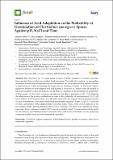Por favor, use este identificador para citar o enlazar a este item:
http://hdl.handle.net/10261/207744COMPARTIR / EXPORTAR:
 SHARE
BASE SHARE
BASE
|
|
| Visualizar otros formatos: MARC | Dublin Core | RDF | ORE | MODS | METS | DIDL | DATACITE | |

| Título: | Influence of Acid Adaptation on the Probability of Germination of Clostridium sporogenes Spores Against pH, NaCl and Time |
Autor: | Valera, Antonio; Olague, Elena; Medina Pradas, Eduardo CSIC ORCID ; Garrido Fernández, A. CSIC ORCID ; Romero-Gil, Verónica CSIC ORCID; Cantalejo, María Jesús; García-Gimeno, Rosa María; Pérez-Rodríguez, Fernando; Posada-Izquierdo, Guiomar Denisse; Arroyo López, Francisco Noé CSIC ORCID | Palabras clave: | Clostridium logistic regression acid-adapted strains predictive models table olives fermented vegetables |
Fecha de publicación: | 24-ene-2020 | Editor: | Multidisciplinary Digital Publishing Institute | Citación: | Foods 9 (2): 127 (2020) | Resumen: | The Clostridium sp. is a large group of spore-forming, facultative or strictly anaerobic, Gram-positive bacteria that can produce food poisoning. The table olive industry is demanding alternative formulations to respond to market demand for the reduction of acidity and salt contents in final products. while maintaining the appearance of freshness of fruits. In this work, logistic regression models for non-adapted and acid-adapted Clostridium sp. strains were developed in laboratory medium to study the influence of pH, NaCl (%) and time on the probability of germination of their spores. A Clostridium sporogenes cocktail was not able to germinate at pH < 5.0, although the adaptation of the strains produced an increase in the probability of germination at 5.0–5.5 pH levels and 6% NaCl concentration. At acidic pH values (5.0), the adapted strains germinated after 10 days of incubation, while those which were non-adapted required 15 days. At pH 5.75 and with 4% NaCl, germination of the adapted strains took place before 7 days, while several replicates of the non-adapted strains did not germinate after 42 days of storage. The model was validated in natural green olive brines with good results (>81.7% correct prediction cases). The information will be useful for the industry and administration to assess the safety risk in the formulation of new processing conditions in table olives and other fermented vegetables. | Descripción: | 18 Páginas.-- 7 Tablas.-- 3 Figuras | Versión del editor: | http://dx.doi.org/10.3390/foods9020127 | URI: | http://hdl.handle.net/10261/207744 | ISSN: | 2304-8158 |
| Aparece en las colecciones: | (IG) Artículos |
Ficheros en este ítem:
| Fichero | Descripción | Tamaño | Formato | |
|---|---|---|---|---|
| foods-09-00127-v2.pdf | Artículo principal | 1,02 MB | Adobe PDF |  Visualizar/Abrir |
CORE Recommender
Page view(s)
138
checked on 18-abr-2024
Download(s)
143
checked on 18-abr-2024
Google ScholarTM
Check
Este item está licenciado bajo una Licencia Creative Commons

